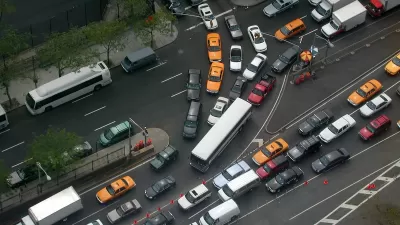Brad Plumer looks at the latest data on Americans' driving habits, which shows that vehicle miles driven have fallen an astonishing 8.75 percent since June 2005. Despite the end of the recession, driving rates continue their downward trend. But why?

Past financial crises have brought about declines in driving rates, but the sustained reduction in vehicle miles driven over the last 92 months, with no end in sight, is unprecedented. So what accounts for this trend? Plumer says that high gasoline prices are one factor, but "not the whole story."
"The other big part of the story is that young Americans are driving much, much less," he says. "Between 2001 and 2009, the average yearly number of miles driven by 16- to 34-year-olds dropped a staggering 23 percent."
"The Frontier Group has the most comprehensive look yet of why younger Americans are driving less. Public transportation use is up 40 percent per capita in this age group since 2001. Bicycling is up 24 percent overall in that time period. And this is true even for young Americans who are financially well off. Here are five big hypotheses:
- The cost of driving has gone up.
- The recession.
- It’s harder to get a license.
- More younger people are living in transit-oriented areas.
- Technology is making it easier to go car-free."
FULL STORY: Why aren’t younger Americans driving anymore?

Planetizen Federal Action Tracker
A weekly monitor of how Trump’s orders and actions are impacting planners and planning in America.

Congressman Proposes Bill to Rename DC Metro “Trump Train”
The Make Autorail Great Again Act would withhold federal funding to the system until the Washington Metropolitan Area Transit Authority (WMATA), rebrands as the Washington Metropolitan Authority for Greater Access (WMAGA).

The Simple Legislative Tool Transforming Vacant Downtowns
In California, Michigan and Georgia, an easy win is bringing dollars — and delight — back to city centers.

The States Losing Rural Delivery Rooms at an Alarming Pace
In some states, as few as 9% of rural hospitals still deliver babies. As a result, rising pre-term births, no adequate pre-term care and "harrowing" close calls are a growing reality.

The Small South Asian Republic Going all in on EVs
Thanks to one simple policy change less than five years ago, 65% of new cars in this Himalayan country are now electric.

DC Backpedals on Bike Lane Protection, Swaps Barriers for Paint
Citing aesthetic concerns, the city is removing the concrete barriers and flexposts that once separated Arizona Avenue cyclists from motor vehicles.
Urban Design for Planners 1: Software Tools
This six-course series explores essential urban design concepts using open source software and equips planners with the tools they need to participate fully in the urban design process.
Planning for Universal Design
Learn the tools for implementing Universal Design in planning regulations.
Smith Gee Studio
City of Charlotte
City of Camden Redevelopment Agency
City of Astoria
Transportation Research & Education Center (TREC) at Portland State University
US High Speed Rail Association
City of Camden Redevelopment Agency
Municipality of Princeton (NJ)




























